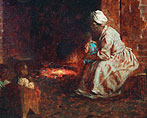Education Higher Education
“All the Slaves Ate Together”: African American Foodways and the Colonial Era

The histories of African American foodways are long and complicated. Despite the often one-dimensional portrayal of this food culture as solely stemming from scraps and offal during enslavement, the reality is much more involved. The foodways of African Americans has changed and evolved since their arrival on these shores in the 1600s and they continue to change today. Throughout time, and especially during enslavement, African Americans have used food and foodways practices not only for nourishment, but also to resist white oppressions—using poison and even theft. But enslaved peoples also used foods as a way of asserting their humanity. By employing techniques of cultural continuity, they applied improvisational skill and ingenuity, using herbs and other medicinals, as well as various foodstuffs.
Using interdisciplinary sources that can be tailored to different courses and subject areas, “All the Slaves Ate Together”: African American Foodways and the Colonial Era helps students gain a deeper understanding of African American food history. By examining the histories of African Americans—with a special focus on the enslaved in the colonial era—students will learn how food can provide a window not only into early society’s beliefs, practices, and mores, but also about the function of food in society as a whole.
The module consists of four one-hour classes, and each class makes use of primary and secondary sources, as well as online resources. Class discussions and activities are an integral part of this module’s success in the classroom. While individual class topics in this module may be used effectively, it is designed to give students a chronological knowledge of the ways in which food communicates a host of issues, even as it serves to satiate. Food and the study of its practices in procurement, preparation, presentation, consumption, and defecation can reveal group belonging, self-identity, emotion, turmoil, community affairs, behaviors, and memories.
Information about the author of the module, suggested uses, and academic objectives are available online at About the Module.
The first class introduces students to the concept of foodways and the ways in which food cultures transcend eating and consumption to include a host of other issues and variables. Archival materials—receipt (recipe) books left by wealthy and gentried white women and men, along with diaries, ledgers, account books, and letters—reveal how and what people of all races and classes ate in the 18th century. This class will incorporate information on West African medicinals and plants that were transported across the Atlantic, and how they were used in the form of teas, poultices, and food for curing ailments. Sometimes, both Europeans and the enslaved used the same herbs and plants, despite the social and cultural divides that came with slavery. It will also familiarize students with the concept of the food event.
The second class looks specifically at Africans brought to and born in America, and what they produced, prepared, and consumed while enslaved. This class will also examine the indelible imprint that African Americans left on American foodways by employing their traditional foodways practices, the skill and ingenuity of African American men and women cooks and chefs, and the actual foods and cultural knowledge of foods that Africans brought to the Americas. This class will also introduce healing plants as a component of African American foodways and the ways in which traditional religions guided their application of herbs and roots to maintain or restore health.
The third class explores staple foods in the colonial era and how these foods were acquired—the Potomac River, the daily market, slave garden plots, and plantation farms. This discussion will also include a study of different cooking methods and ingredients used by colonists and slaves. One of the highlights of this class will be herbalism and how remedies were borrowed and exchanged by Africans and Europeans to treat for illnesses and diseases. It will consider how some African cultivated foods—benne (sesame), yams, okra, and black-eyed peas—were served for medicinal purposes. Lastly, we will consider the precision involved in mealtimes—the dinnerware that was used and the specificity with which the meal rituals were enacted. Students will come to know the important role that enslaved people had in ensuring these processes were well choreographed.
The final class helps students to understand the complex relationship between enslaved people’s lives and the constant quest for freedom. This class will dispel any notion that enslaved people—no matter how well treated—were happy to be enslaved. Using specific case studies found in the archival material, students will come to understand the intersections of food and freedom, and how the enslaved used food practices as a means of overtly resisting white oppression and control. These acts ranged from using medicinal herbs to poison and/or sedate, to burning food and ultimately, to using food events such as major holidays to escape bondage.


